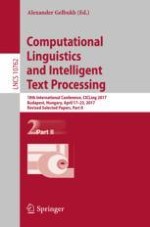
2018 | OriginalPaper | Chapter
A Comparison Among Significance Tests and Other Feature Building Methods for Sentiment Analysis: A First Study
Authors : Raksha Sharma, Dibyendu Mondal, Pushpak Bhattacharyya
Published in: Computational Linguistics and Intelligent Text Processing
Publisher: Springer International Publishing
Activate our intelligent search to find suitable subject content or patents.
Select sections of text to find matching patents with Artificial Intelligence. powered by
Select sections of text to find additional relevant content using AI-assisted search. powered by